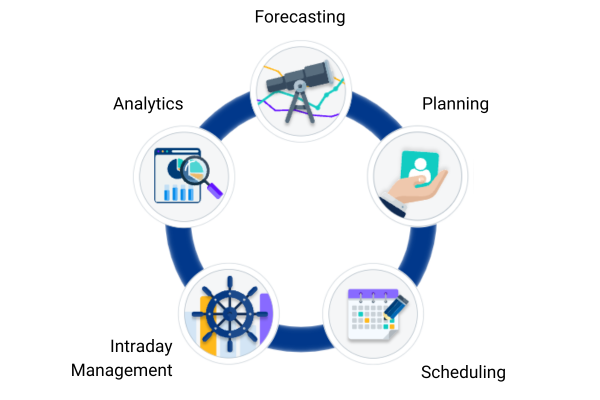Introduction

The goal of workforce management (WFM) is to optimize the deployment of the most valuable - and costly - resource in every contact center: the employees.
“WFM is about having the right number of people in the right places at the right times, doing the right things.”
Why does WFM matter?
In every organization, three opposing forces are in play:

- Exclusively focusing on the customer by always having plenty of employees to handle demand is great for company reputation and may result in revenue growth, but could render the business unprofitable.
- Putting the employee first may make the company a great place to work, but if the customer experience is terrible and staffing costs are excessive, your organization may be a place where nobody works in the long run.
- Well-run businesses are always looking for ways to optimize costs, but reducing staffing levels without regard for the customer experience or employee burnout is equally unsustainable.
WFM matters because it enables organizations to optimize the balance between the three forces, simultaneously improving outcomes for the customer, the employees, and the business. If that sounds too good to be true, read on to learn how WFM performs this seemingly impossible balancing act.
How does WFM work?
WFM is a repeating process and that’s why it is often characterized as a cycle:

- It starts with forecasting, which predicts future workload and staffing requirements based on historical data like work volume and average processing time, together with business intelligence inputs, such as upcoming marketing campaigns.
- Planning is about making sure that your business employs the right number of people to cope with the anticipated scale of the business in the long term.
- Scheduling is about creating shifts for employees that match supply and demand for staff as closely as possible, as often as possible. You must take into account skills, labor laws, employment contracts, and other constraints.
- Intraday management is about identifying where reality has deviated from the plan, for example, an unexpected spike in demand or unusually high sickness levels among employees. It enables you to take swift and effective corrective action to defend your KPIs.
- Analytics give you insights that will help you to constantly improve. For example, if you measure time spent on non-productive activities such as sickness and time off, you can enhance the accuracy of your staffing calculation in the next cycle.
Employee engagement is about letting your employees interact with the planning process and feel more in control. It underpins the whole WFM process.
What impact does WFM have?
Here is what “the right number of people in the right places at the right times, doing the right things” looks like:
Without WFM:

With WFM:

In both charts, the green line shows the demand-driven staffing requirement for a single activity for a single day. This represents the number of employees required in each time interval to handle the workload. In a contact center, for example, workload is based on the number of incoming customer contacts (e.g. calls, chat messages, emails, etc.) and the average handling time in that interval. The horizontal bars show the shifts assigned to employees across the day.
In the first chart, it’s clear that we rarely have the right number of employees in the right places at the right times. There are periods in the morning and afternoon, highlighted in orange, when insufficient employees are scheduled. At those times, the customer experience suffers and the employees get stressed. At other times, highlighted in red, there are too many employees on duty. This is a waste of the organization’s budget.
The second chart shows what WFM does: supply and demand are much more closely aligned.
Impact:
- Satisfied customers
- Happier employees
- Optimized business bottom line
Getting WFM right is definitely not a trivial task. Click on the chapter headings on the right to walk through the WFM cycle step by step, starting with.
Rather talk than read? At injixo, we live, eat and breathe WFM. We don’t have any salespeople on commission. What we do have is a team of experts who are passionate about WFM and the transformation that it can bring about. If you’ve read enough about WFM to know that it’s worth investigating, why not arrange a call with us?






